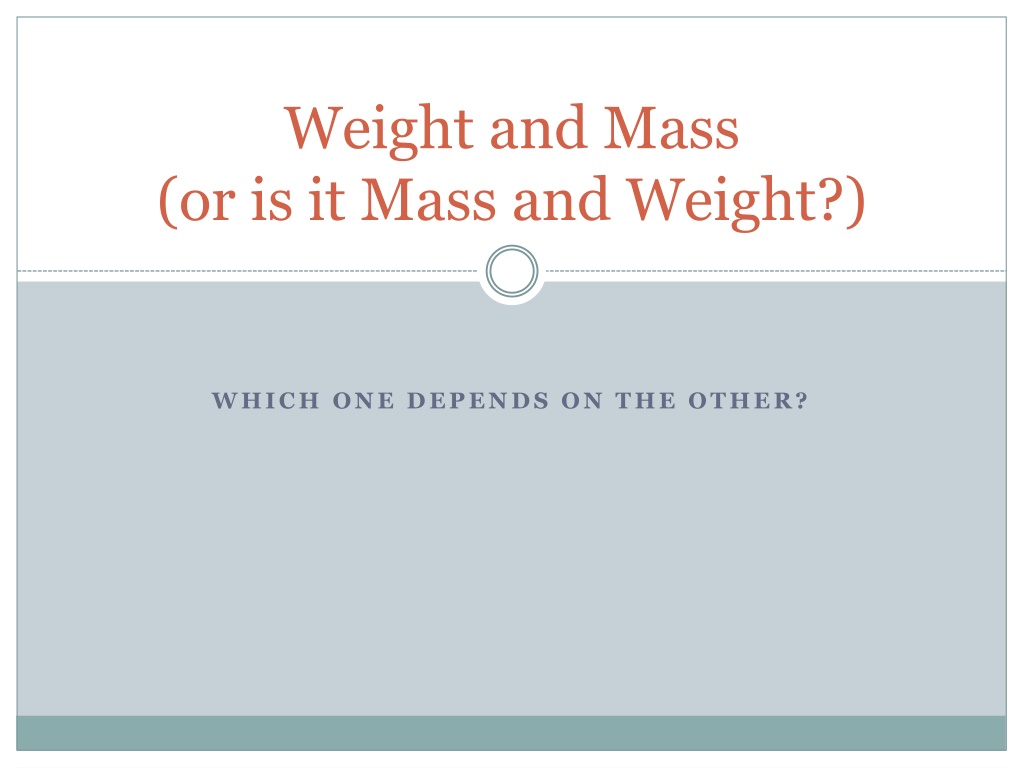Understanding Weight and Mass in Physics
Weight and mass are two fundamental concepts in physics that are often misunderstood. Weight is the gravitational force acting on an object, while mass is the measure of its inertia. This article clarifies the relationship between weight and mass, explains the force of gravity, and discusses how these concepts are applied in various scenarios.
Download Presentation

Please find below an Image/Link to download the presentation.
The content on the website is provided AS IS for your information and personal use only. It may not be sold, licensed, or shared on other websites without obtaining consent from the author. Download presentation by click this link. If you encounter any issues during the download, it is possible that the publisher has removed the file from their server.
E N D
Presentation Transcript
Weight and Mass (or is it Mass and Weight?) WHICH ONE DEPENDS ON THE OTHER?
True or False The force of gravity is the same for all objects on earth. 2. Gravity is caused by the rotation of the earth. 3. There is no gravity on the moon. 4. A chicken in a vacuum experiences no gravity. 5. You exert as large a gravitational force on the earth as it exerts on you. 1.
Lab What is the mathematical relationship between the gravitational force on an object (aka: its weight) (N) and its mass (kg) on earth?
Weight = mass x g The weight of an object is directly proportional to its mass, as shown by the equation weight=9.81(mass). This means if an object s mass is tripled, its weight triples, and if its mass is halved, its weight is also halved. For example, a 4 kg watermelon would weigh 39.2 N, which is four times the 9.8N that a 1kg mango would weigh.
What is weight? The size of the gravitational force on a body, exerted by Earth (or the chunk or matter body is on). NOT 9.81 for all objects NOT the same for all objects The magnitude of the gravitational force Units: N (newton) Fg=9.81m or Fg = mg (g = gravitational field strength, OR accel. due to gravity g = 9.81N/kg or m/s/s) Measured with a spring scale
The size (magnitude) of the gravitational force a planet exerts on an object on or near the planet Fg = mg This force acts WITHOUT CONTACT so it cannot be directly measured. Fg: weight A 1.0kg mass weighs 9.8N SI unit: N (newton) Weight is NOT 9.8 for all objects (a 5.okg mass weighs 49N) The force of gravity is NOT the same for all objects! alternate units: pounds, stones, dynes
What is mass? The measure of an object s resistance to acceleration (inertia) One of the two properties of all matter A SCALAR Measured in kg in the SI system NOT the force of gravity NOT weight Measured by trying to accelerate object
A measure of the amount of inertia (resistance to acceleration) for an object. Mass is one way to measure how much of something you have. Mass is a fundamental property of matter, there is no formula to define it. m: mass (scalar) 1.0 liter of water has a mass of 1.0kg SI unit: kg (kilogram) Mass does NOT change for an object, regardless of where it is in the universe, unless the amount of matter changes alternate units: gram, slug
Ex What is the weight (in N) of a 30 kg suitcase? An astronaut weighs 700N on Earth. How much does he weigh on the moon (where g=1.6N/kg)? A 30 kg child sits on a swing that consists of a level wooden platform suspended by two vertical chains. Determine the tension in each chain if the child positions herself in the exact middle (midway between the chains).

 undefined
undefined









































